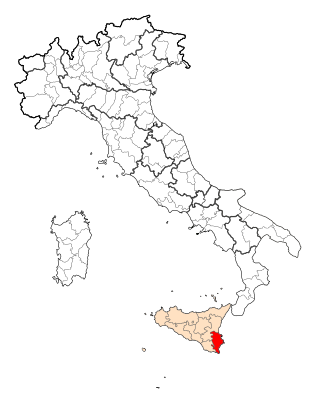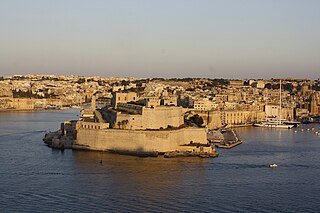
Sicily is the largest and most populous island in the Mediterranean Sea and one of the 20 regions of Italy. The Strait of Messina divides it from the region of Calabria in Southern Italy. It is one of the five Italian autonomous regions and is officially referred to as Regione Siciliana. The region has 5 million inhabitants. Its capital city is Palermo.

Catania is the second largest municipality in Sicily, after Palermo. Despite its reputation as the second city of the island, Catania is the largest Sicilian conurbation, among the largest in Italy, as evidenced also by the presence of important road and rail transport infrastructures as well as by the main airport in Sicily, fifth in Italy. It is located on Sicily's east coast, at the base of the active volcano, Mount Etna, and it faces the Ionian Sea. It is the capital of the 58-municipality region known as the Metropolitan City of Catania, which is the seventh-largest metropolitan city in Italy. The population of the city proper is 311,584, while the population of the Metropolitan City of Catania is 1,107,702.

Barcellona Pozzo di Gotto is a town and comune of about 50,000 inhabitants in the north coast of Sicily, Italy, 40 kilometres (25 mi) from Messina towards Palermo. It belongs to the Metropolitan City of Messina.

Corleone is an Italian town and comune of roughly 11,158 inhabitants in the Metropolitan City of Palermo, in Sicily.

The Aeolian Islands, sometimes referred to as the Lipari Islands or Lipari group after their largest island, are a volcanic archipelago in the Tyrrhenian Sea north of Sicily, said to be named after Aeolus, the mythical ruler of the winds. The islands' inhabitants are known as Aeolians. The islands had a permanent population of 14,224 at the 2011 census; the latest official estimate is 15,419 as of 1 January 2019. The Aeolian Islands are a popular tourist destination in the summer and attract up to 600,000 visitors annually.

The Kingdom of Sicily was a state that existed in the south of the Italian Peninsula and for a time the region of Ifriqiya from its founding by Roger II of Sicily in 1130 until 1816. It was a successor state of the County of Sicily, which had been founded in 1071 during the Norman conquest of the southern peninsula. The island was divided into three regions: Val di Mazara, Val Demone and Val di Noto.

The term Norman architecture is used to categorise styles of Romanesque architecture developed by the Normans in the various lands under their dominion or influence in the 11th and 12th centuries. In particular the term is traditionally used for English Romanesque architecture. The Normans introduced large numbers of castles and fortifications including Norman keeps, and at the same time monasteries, abbeys, churches and cathedrals, in a style characterised by the usual Romanesque rounded arches and especially massive proportions compared to other regional variations of the style.

The Province of Syracuse was a province in the autonomous island region of Sicily in Italy. Its capital was the city of Syracuse, a town established by Greek colonists arriving from Corinth in the 8th century BC. It had an area of 2,109 square kilometres (814 sq mi) and a total population of 403,985 (2016). Syracuse had 8% of the Sicilian population and 8.2% of Sicily's area.

The Battle of Malta took place on 8 July 1283 in the entrance to the Grand Harbour, the principal harbour of Malta, as part of the War of the Sicilian Vespers. An Aragonese fleet of galleys, commanded by Roger of Lauria, attacked and defeated a fleet of Angevin galleys commanded by Guillaume Cornut and Bartholomé Bonvin.
Louis the Child was King of Sicily from 15 September 1342 until his death. He was a minor upon his succession, and was under a regency until 1354. His actual rule was short, for he died in an outbreak of plague the next year. His reign was marked by civil war.

Castello Ursino, also known as Castello Svevo di Catania, is a castle in Catania, Sicily, southern Italy. It was built in the 13th century as a royal castle of the Kingdom of Sicily, and is mostly known for its role in the Sicilian Vespers, when it became the seat of the Sicilian Parliament. The castle is in good condition today, and it is open to the public as a museum.

Randazzo is a town and comune in the Metropolitan City of Catania, Sicily, southern Italy. It is situated at the northern foot of Mount Etna, c. 70 kilometres (43 mi) northwest of Catania. It is the nearest town to the summit of Etna, and is one of the points from which the ascent may be made.

Aci Castello is a comune in the Metropolitan City of Catania in Sicily, Italy. The city is located 9 kilometres (6 mi) north of Catania on the Mediterranean coast. The primary economic sectors are agriculture and industry. The city is neighbored by Aci Catena, Acireale, Catania, San Gregorio di Catania and Valverde.

The War of the Sicilian Vespers or just War of the Vespers was a conflict that started with the insurrection of the Sicilian Vespers against Charles of Anjou in 1282 and ended in 1302 with the Peace of Caltabellotta. It was fought in Sicily, Catalonia and elsewhere in the western Mediterranean between the kings of Aragon on one side against the Angevin Charles of Anjou, his son Charles II, the kings of France, and the Papacy on the other side. The war resulted in the division of the old Kingdom of Sicily; at Caltabellotta, Charles II was confirmed as king of Sicily's peninsular territories, while Frederick III was confirmed as king of the island territories.

Lentini is a town and comune in the Province of Syracuse, southeastern Sicily.

The Castello Normanno, or alternatively the Castello di Aci, is a castle in Aci Castello in the Metropolitan City of Catania in Sicily, southern Italy. The castle is situated on a rocky outcrop jutting out into the sea. Its precise date of construction is uncertain, but it was important to the development of its region during the Middle Ages. During the War of the Sicilian Vespers, it was subject to Roger of Lauria. It was besieged more than once, and was briefly controlled by the Spanish. It is currently a museum.

Forte del Santissimo Salvatore, also known as Castello del Santissimo Salvatore, is a fort in Messina, Sicily. It was built in the mid-16th century, and it is still military property. Some of its walls were demolished after the earthquake of 1908, but the rest of the fort is still intact.

The fortifications of Messina were a series of defensive walls and other fortifications which surrounded the city of Messina, Sicily. The first walls were built during the Middle Ages in around 1200. A system of bastioned fortifications was constructed around the city in the 1530s and 1540s. The fortifications were modified over the years, with the last major addition being the Real Cittadella, which was built in the 1680s. Most of the walls were demolished in the 19th and 20th centuries, but some parts of the walls still survive today.

Dina and Clarenza are two women connected in legend with the historical siege of Messina by Charles I of Anjou during the Sicilian Vespers in August 1282.

Macalda di Scaletta was a Sicilian baroness and lady-in-waiting during the Angevin and Aragonese periods. The daughter of Giovanni di Scaletta and a Sicilian noblewoman, Macalda was noted for her unscrupulous political conduct, inclination to betray marriage, and for her promiscuous sexual habits; this dissoluteness, even having a brush with "suspicion of incest," tended to degenerate into an "exhibitionism veined with nymphomania." She was the wife of the Grand Justiciar of the Kingdom of Sicily, Alaimo da Lentini.






















